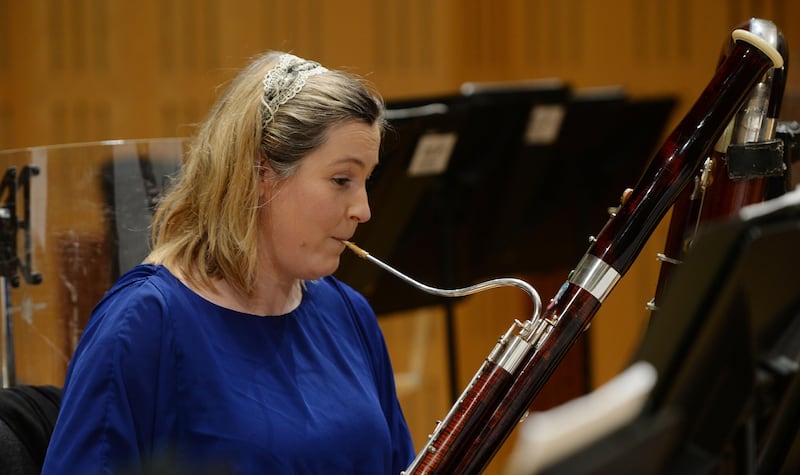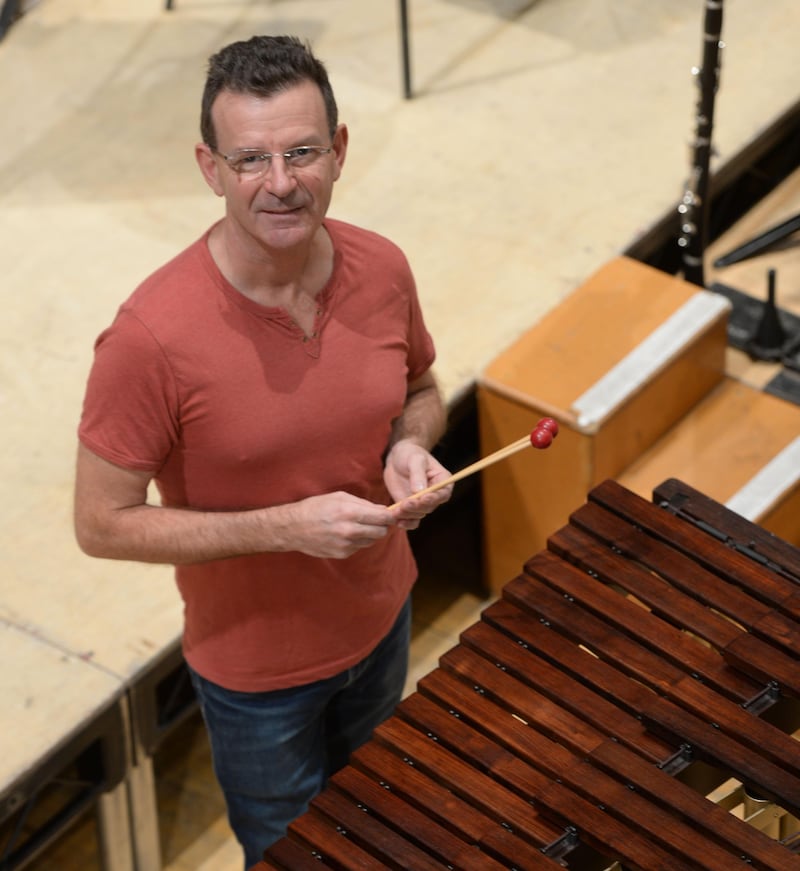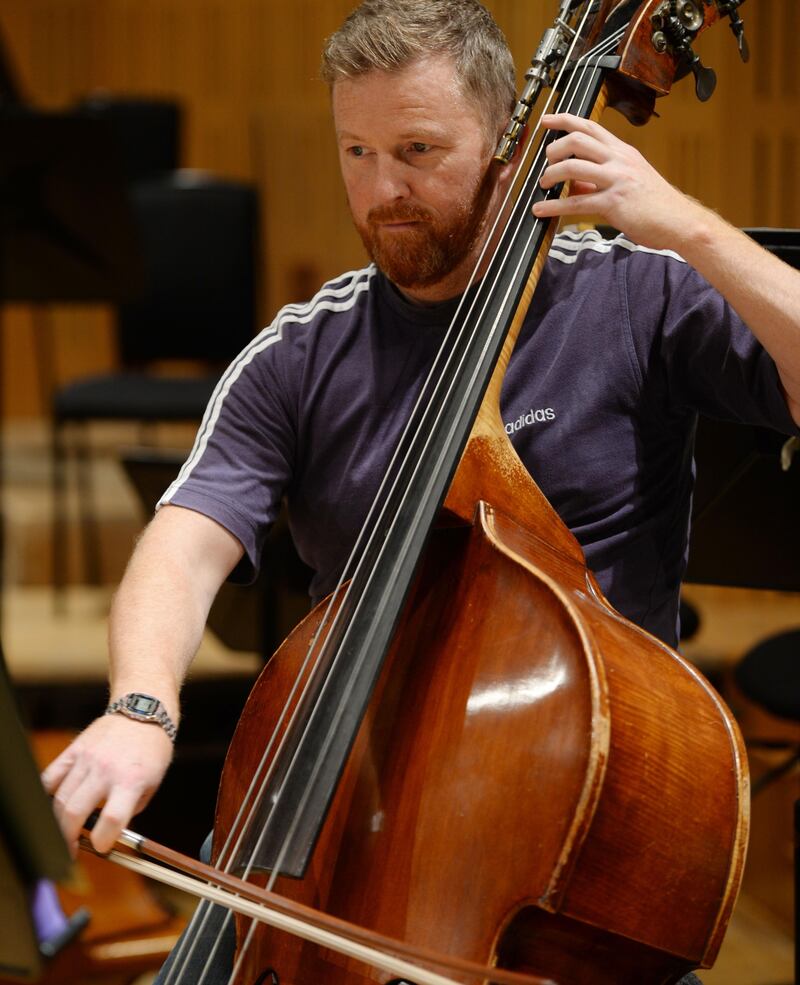I'm sitting in the National Concert Hall café, chatting to musicians from the RTÉ National Symphony Orchestra about the mental and physical strains of playing music professionally.
A group of players – a cellist, a double bass player, a flautist, a bassoon player, two violists and two percussionists have volunteered to talk about the various ailments that beset classically trained musicians who rehearse for up to 25 hours a week and then give public performances on Friday evenings in the National Concert Hall from September to May.
"Carrying around the cello is the main thing that affects us," says cellist Martin Johnson as he demonstrates how he carries his cello case with rucksack-style straps across his back. Most cello cases are now made from carbon fibre, which is a lot lighter that the older ones made from fibreglass or wood.

“The common problems we have are lower back, shoulder or neck pain. Nobody plays at a high level on a regular basis without having some ailment or other,” says Johnson.
Flautist Catriona Ryan agrees. "There isn't anyone amongst us who hasn't been to a physiotherapist or a physical therapist at some point. My back went out when I was 24 and I couldn't move for a week. It was due to repetitive strain. You do that once and then you realise you have to do things to compensate holding your body in an unnatural position for extended periods of time," says Ryan, who moves her flute to the opposite side of her body during rehearsals to relieve the muscles used for playing.
Mark Jenkins is one of seven double bass players in the National Symphony Orchestra. He does a mix of pilates , yoga and movements he learned from the Alexander Technique to deal with repetitive strain-type injuries. "I do 20 minutes of exercises straightaway when I get up in the morning and I swim in the sea most nights throughout the year."
Jenkins has suffered severe pain while playing the double bass. “I’ve had a prolapsed disc in my back and neck issues because of posture. Dealing with the double bass is like wrestling a bear – it’s the most physical instrument in the orchestra. It’s huge but it’s not big enough for its sound so playing it is very physically involved.”

Percussionists also have to deal with large, heavy instruments which can cause physical strain. "You have to be conscious of your centre of gravity and not over stretch your back and not look down too much if you're playing the xylophone or the vibraphone," says Bernard Reilly, who does regular ashtanga yoga. "The practice of yoga is about calming the mind so that there isn't any inner chat or distraction," he explains
Surprisingly, percussionists say it’s playing the soft notes rather than the loud ones that are most challenging. “A lot of people think we’d under stress when we are playing loud but it’s the opposite. It’s the pieces you have to be physically really soft for that are more stressful. Starting the rhythm is the hardest thing to do,” says Richard O’Donnell, the principal percussionist. O’Donnell goes to the gym four or five times a week, cycles to work and walks his dogs to unwind.
Postural issues
The sometimes-congested physical space given to different sections of the orchestra can also lead to postural issues and pain. Violinist Brona Fitzgerald describes playing the fiddle in the orchestra as like "holding a sack of potatoes the wrong way round". "I'm lucky in that I'm relaxed but I'm short [in stature] and sometimes I'm too physically close to the next violinist and I get migraines from straining my body into a tighter position. I walk by the sea every day to unwind and relax."

And, the air-conditioning in the National Concert Hall can also make playing more difficult – especially for wind instrument players who need all the clean air they can get to play their instruments fluidly. "You need buckets of air to play the bassoon and particularly the contra-bassoon so you can feel a bit light-headed if you're not feeling well," says Hilary Sheil, who plays both the bassoon and the contra-bassoon. "Because we're sitting all day in rehearsals, I do a bit of running, which helps. A lot of people go for massages to ease out their muscles," she says.
“You have to be really careful with your lungs. There are more issues with asthma and chest infections for those of us who play wind instruments,” says flautist Catriona Ryan. “The wind instruments need the most air but sometimes that cold air passes over the shoulder of the violinists and you can’t move or put on a jacket if you’re cold,” adds Fitzgerald.
There are mental as well as physical strains. Playing a musical instrument in an orchestra requires an incredible level of simultaneous attentiveness, according to Elaine Clark, first violinist with the RTÉ National Symphony Orchestra. "If you consider that you have 14 violinists playing in one voice so you have to take on board your own sound and how it blends with the other violins and then how that goes with the rest of the strings and the whole orchestra. Then, you have to play attention to the lead violinist and the conductor," explains Clark. And what about the audience? "Ideally, the audience doesn't come into it – although that's the reason why you're there," she says with a smile.

All musicians suffer from some level of performance anxiety and arguably, they wouldn’t be giving their best if they didn’t have some level of nerves before public performances. “Talking about performance anxiety is a bit of a taboo. It gets harder with age and you’re not in control of the amount of nerves. You need to keep your brain quiet and just play. Sometimes we can self-sabotage and need positive comments to keep us going,” says Ryan.
Johnson agrees. “Sometimes, you feel like you’re playing terribly but nobody notices. How you play can become overblown in your head and the audience won’t even notice. The fear of [not]performing [well]never fully goes away.”
Ryan says that performance anxiety can also convert into tension in the body. “We feel like there’s a microscope on us when we’re performing – and being watched by the critics with their iPads lighting up in front of them. There is often great tension before playing a quiet note or doing a solo.”
What impact does the conductor’s style or manner have on musicians? “Some conductors will constantly criticise and you don’t get the best out of people if we end up feeling that anything we do is wrong. I think the conductor should encourage with constructive and positive remarks because really it’s about the music,” says Clark.
However, Clark says that the members of the orchestra are very supportive to each other. Even sitting in their company, I can see the shared banter that goes on between them. “People tell us that we’re so lucky to be doing such a creative job but it’s mostly discipline. Part of the illusion of a seamless and beautiful musical performance comes from all that discipline. When you’ve got a good programme, a good conductor and a good audience, the buzz is tremendous,” says Fitzgerald.
“It’s a performance career so if the audience thinks it’s easy then we are doing our job well. Sometimes we worry about people thinking we look very serious but music is our passion and we can’t always show that on our faces when we are performing. You can feel quite euphoric after a concert,” says Ryan.
She adds: “Music can be emotionally therapeutic and we take that for granted. When I am in rehearsals on the first day back after my holidays, I realise that this is an incredible thing to do with my life.”
THE LIFE OF THE NATIONAL SYMPHONY ORCHESTRA
The RTÉ National Symphony Orchestra (NSO) performs major orchestral works live every Friday evening during its main season from September to May. The orchestra also tours to venues around the country and abroad and performs at special commemorative events. In July, 2017, the National Symphony Orchestra performed to more than 2,500 people in the National Centre for the Performing Arts in Beijing, China.
Musical performance at a professional level requires a high level of training and skill, emotional intelligence and self-control. On a performance night, players have to read thousands of musical notes and reproduce them on their instruments, shifting tempo and loudness according to the musical direction of the conductor.
The NSO offers a mentoring scheme, guiding students in rehearsals and concerts with the orchestra. The orchestra also performs the works on the Junior and Leaving Certificate music courses each year to give secondary school students and their teachers an opportunity to hear these works performed in a live setting. Concerts for primary school children introduce younger children to the sounds of the different instruments and how a conductor keeps the musical beat.
This season, the RTÉ NSO is celebrating its 70th anniversary with a birthday gala concert on February 14th, 2018.





















